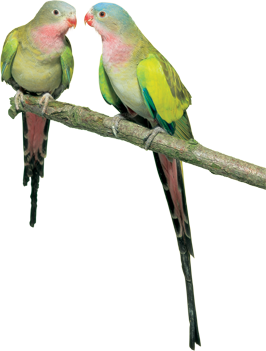Profiles
PRINCESS PARROT
(PolytelisAlexandrae)
Family: Parrot
Origin: From the Fitzroy River and Coolgardie in Western Australia and eastward to northern South Australia
Size: 450mm including a 280mm tail.
Description:
The male has a light blue crown and nape. The forehead and sides of the head are pale blue-grey. Its throat and front neck are rosy pink.
The mantle, back and wings are pale olive-green with the wing coverts bright yellow-green. The underwing coverts are blue-violet and its glorious central tail feathers are olive-green with sparkling blue tips. The outer edge tail feathers are blue-grey edged with rose pink.
Splashed in colour the breast and belly of the male is blue-grey tinged with green and yellow. Its thighs and lower flanks are rose pink while the rest of its flanks are washed with blue. The under tail coverts are olive-yellow, the eyes are orange, the beak is coral and the legs are grey.
The female bird has a grey-mauve crown, the rump and upper tail coverts are grey-blue; the wing coverts are duller and greener and the central ail feathers are shorter than that of the male. The immature chicks are similar looking to the female and mutations of this species do occur occasionally.
Care:
When living in the wild the Princess Parrot likes to nest in hollow limbs and lay its eggs in wood dust. In a domestic environment hollow logs can still be provided in a large aviary along with nesting boxes. And can be bred in a colony where all the birds are placed in the aviary at the same time.
Clean food and water dishes along with fresh seed, greens and fruit should be given daily. These birds are susceptible to worm infestations and should be wormed.
Eats:
A good quality, mixed small parrot seed should be given as often as needed and the husks need to be removed each day. Fresh fruit and vegetables, a cuttlefish bone and grit also need to be provided along with fresh water. It’s also a good idea to provide a wide shallow dish so the birds can take a bath as they love to splash about in water.
In the wild these birds would eat seed grasses and herbaceous plants, acacia blossoms and berries. And this bird likes to eat seed at ground level and not high up, so you will need to consider this when keeping them as pets.
Features:
If disturbed in the wild, these birds will fly to the nearest tree and perch lengthwise on a large limb in a bid to avoid being seen. They will normally breed from September to January and will usually lay from four to six eggs. The eggs are incubated for 20 days by the female only and once hatched the chicks spend just five weeks in the nest before flying off and fending for themselves. The males get their adult feathers in their second year.
Call:
They let out a rattling, cackling shrill sound as well as a soft twittering sound.
Personality:
Princess Parrots are gentle-natured birds and very pretty, but don’t let this fool you as they are very hardy animals too.
During the mating season the male will perform a courtship dance where it will erect a few feathers on its forehead to form a tiny crest in a bid to impress the female and so get it to mate with it.
